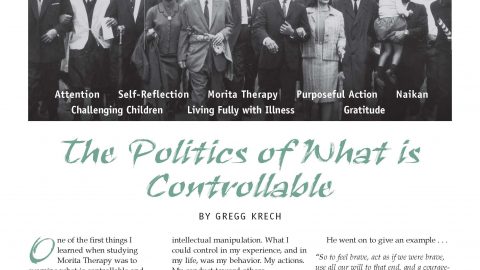Where East Meets West:
Morita Therapy and Acceptance and Commitment Therapy
(ACT)
By Dr. Richard Blonna
Acceptance and Commitment Therapy (ACT), is a “third-generation” form of Cognitive Behavior Therapy (CBT) that became prominent in the Western psychotherapeutic community in the early 2000’s in America (Hayes, 2004, 2005). In many ways, ACT is remarkably similar in theory and application to Morita Therapy, conceived by Shoma MORITA in the early 20th century in Japan (Morita et. al, 1998). This article will explore these similarities and examine key differences between these two approaches to dealing with the pain and suffering associated with life.
The Origins of Morita Therapy
Morita therapy was developed by the Japanese psychiatrist Shoma MORITA (1874-1938). Morita had a distinctly Eastern, Zen-based perspective on psychological
illnesses such anxiety disorders. It is fascinating to realize that Morita was acontemporary Sigmund Freud, William James, Carl Jung, and others who helped shape
the emerging Western psychotherapies. Zen Buddhism influenced Morita theory and practice in a few key ways. In Zen Buddhism, there is no separation between nature and the human spirit, they are one. Because of this, Morita viewed the mind and body as one and that anxiety disorders (his primary focus) and other psychological illnesses were a result of body-mind or mind-body interactions. Further, since physical, emotional, and psychological activities of humans are naturally occurring phenomenon, they coexist and cannot be manipulated or changed artificially. Morita felt that because of this, the best way to deal with them was
to let them follow their natural course (Morita et al., 1998).
In particular, emotions and knowledge coexist, despite their often contradictory nature. There are two ways to deal with this; accept this reality and live your life or try to change or avoid it and run from life. Morita uses the example of being frightened by caterpillars to illustrate this. The first person, frightened by the sight of the caterpillar, turns his back and runs from it. The second person, despite being disgusted and frightened by the caterpillar, picks it up, moves it aside, continues on with his path, and reflects on his ability to coexistence with this distasteful insect (Morita et al., 1998).
Morita believed in two different forms of knowledge, taitoku, the knowledge derived from direct experience, and rikai, knowledge derived from inference and used to
judge how things should or should not be (Morita et al., 1998). This way of viewing knowledge sets the stage for Morita therapy’s use of mindfulness to help clients be more mindful of what is (the reality of their lives) compared to what should be (making judgments about how life should be).
In many instances, Morita embraced some of the concepts of his Western therapeutic contemporaries. A good example of this is Morita’s view Freud’s theory of
the unconscious. Morita believed, as Freud did, in the existence of the unconscious. He didn’t view it however as some physical structure in the brain. Rather, Morita viewed the unconscious as some force that transcended the physical presence of the brain. It had its own essence, ebb, and flow. Morita describes the nature of emotions in a similar vein; transient, with the ability to appear and disappear on their own. Morita’s view of the unconscious is more like Jung’s notion of the collective unconsciousness which is more spiritual and links it to all humans across time. Morita conceived of this notion decades before Jung published it (Morita, 1998). Morita therapy is guided by five principles of emotions. The following five principles of feelings clearly illustrate the differences between Eastern and Western
psychological traditions. They were synthesized by David K Reynolds (2002) and used in the development of his Morita-based approach entitled Constructive Living.
Principle # 1. Feelings are not controllable by the will.
While we might be able to clearly identify what we are feeling, and even understand its relationship to our stress, we can’t switch feelings on and off. In other words, we can’t make ourselves feel anything. Feelings come and go, we cannot directly control them by our sheer will alone. What we can control is our behavior, what we do in response to these feelings.
Principle # 2. Feelings must be recognized and accepted as they are.
Rather than feel guilty or upset about feeling something, it is better to note what you are feeling, accept it, and move on. Since feelings arise on their own, and this is
beyond our ability to control, it doesn’t make sense to feel responsible for them and feel bad for being unable to control them.
Principle # 3. Every feeling, however unpleasant, has its uses.
Acknowledging that you are feeling guilty, for instance, can cause you to examine your behavior. Admitting that you are feeling angry can help you identify the source of your anger and show you that something upsets you enough to trigger such strong emotions. Realizing that something causes you to feel afraid can motivate you to try to gain control over the situation.
Principle # 4. Feelings fade in time unless they are re-stimulated.
Feelings, both positive and negative diminish over time. Unless we do something to re-stimulate them (like constantly think about them and sub-vocally bring them up) feelings will start to fade.
Principle # 5. Feelings can be indirectly influenced by behavior.
Feelings change in response to behavior. For instance, you can help negative feelings dissipate more rapidly by doing something productive. This will not only take
your mind off your bad feelings it will trigger new feelings of accomplishment. The worst thing to do whenever you are experiencing negative feelings is to sit around and think about them. This will constantly keep them in the forefront of your mind and keep them alive. It is better to do something productive so you stop thinking about the negative feelings.
The Origins of ACT
ACT has its roots in cognitive behavioral therapy. The traditional core theoretical framework of CBT revolves around the belief that pain, suffering, and negative behavior are caused by the illogical and irrational cognitions and self-talk (what people think and say to themselves) that clients have about specific people, events and situations. Further, traditional CBT approaches insist that changing illogical thought patterns and getting rid of painful emotions are necessary before people can rid themselves of negative behavior patterns (Luoma, Hayes & Walser, 2007).
Let me use fear of public speaking as an example. Imagine you were just told by your boss that tomorrow you would have to address your work group (about 100 people) regarding the status of a project you were in charge of. If you were one of the millions of Americans who suffer from social anxiety disorder you would probably feel severe anxiety and other physical symptoms such as sweating, muscle tension, and dizziness when given this task. Accompanying these emotional and physical symptoms you might find yourself caught up in the following illogical thinking “I’ll just die if I have to give this speech”, “I’ll fall apart right on that stage”, and negative self-talk, “I’m the world’s worst public speaker” or “I am such an idiot for feeling like this.” Typically, your first response to this might be trying to avoid the situation (negative behavior pattern) by asking you boss if someone else could give address the group.
CBT therapists would say that “avoidance” (avoiding painful experiences and situations). is a negative behavioral response to this task (public speaking) because it is a personally-limiting response. When people avoid public speaking in front of groups they cut off many potential avenues of growth and development. They avoid certain types of occupations or refuse promotions because they require public speaking (even though they love all of the other aspects of the job). They also miss out on the opportunity to meet new people that might lead to new friendships or important networking opportunities.
Traditional CBT approaches to dealing with the pain and suffering associated with problems such as public speaking revolve around changing the illogical thinking and negative self-talk and getting rid of the painful emotions. As mentioned above, a key to understanding traditional CBT is the belief that changing illogical thoughts and eliminating painful emotions are necessary, and must occur before people can rid themselves of negative behavior patterns such as avoidance.
How ACT Differs from Traditional CBT
ACT is derived from Relational Frame Theory (RFT) which proposes that all current behavior is based on frames of reference (relational frames) learned in the past.
All thoughts and actions are tied to a particular context (the frame in which the learning occurred). Further, ACT theory posits that current behavior does not have to be experience-driven, it can be motivated entirely by the brain’s ability to use information from the past (previous relational frame). Previous relational frames are used to extrapolate to current and future situations (Hayes, Barnes-Holmes, and Roche, 2001).
Let’s use the work-related public speaking example to illustrate this. Let’s assume that the original frame of reference for your current distress related to public speaking was a failed high school presentation to 20 fellow students in an English class over 25 years ago. Everyone in your high school English class was required to give a ten minute speech about a book they were required to read over the winter break.
You can close your eyes and remember the event as if it had happened yesterday. Even though you read the book, understood it completely, and enjoyed it immensely, when you stood in front of the class you started sweating, your tongue felt three inches thick in your dry mouth, and you froze, unable to utter a word. All of the other students laughed and the teacher, after letting you suffer for what seemed like an eternity, dismissed you with a curt remark about being unprepared.
Since then, all the thoughts, feelings, and actions you’ve had about public speaking have been filtered through the original frame of reference (the relational frame)
of that experience (the failed high school speaking assignment). In college you agonized over every class that has a speaking requirement. You avoided most of them by dropping out as soon as you realized the public speaking requirement. Up until this point in your career you have managed to avoid most of the situations that have required that you speak in public. At 37, you are very successful and accomplished in a number of different areas, yet twenty years removed from this initial experience your fear of public speaking still haunts you.
Unlike traditional CBT approaches, ACT does not believe it is necessary to change illogical thinking and irrational self-talk, and remove painful emotions in order to
treat pain and suffering and negative behavior. Further, research from RFT demonstrates that rather than helping eliminate painful emotions and negative thoughts and self-talk, “working” on them actually results in clients focusing on them more (Luoma, Hayes & Walser, 2007, Hayes, 2005). If you apply this to the public speaking example, according to ACT theory, the more you think about the dreaded event, the greater the likelihood that you will worry about it and magnify the anxiety associated with it. This sounds a lot like what MORITA describes when he talks about how trying to control or change our emotions only magnifies them and makes them worse (Morita et. al, 1998).
Unlike CBT, which tends to view the brain as a computer and examines how it processes information, ACT is concerned with how the mind functions under different
contexts (micro-environments) in relation to one’s value structure (the whole person acting in a context towards something valued). There are two main components to ACT, acceptance and commitment. ACT therapists use many different forms of metaphors and mindfulness techniques to help clients explore both components.
There are three components to teaching acceptance, (1) helping clients be more mindful of their thoughts, emotions, and actions, (2) helping clients understand how their actions support or oppose their values and (3) showing clients how attempts to eliminate or avoid painful thoughts, feelings, and actions are fruitless and can actually increase their suffering.
The commitment component of ACT helps clients commit to actions that are consistent with their values and goals. Therapists show clients that they can take
committed action in valued directions, despite their pain and suffering. Clients learn that they do not have to eliminate their painful thoughts and feelings before getting on with their lives.
Where East Meets West
It is interesting to note that references to Morita Therapy are absent from the literature of both Relational Frame Therapy and Acceptance and Commitment Therapy. In actuality, ACT and Morita Therapy converge both theoretically and in practice in several ways.
Theoretical Similarities
1. ACT and Morita Therapy are grounded in the belief that thoughts and emotions have the potential to influence behavior. This is vastly different from saying that thoughts and feelings determine behavior. ACT derives this from traditional CBT which describes the role of illogical thinking and irrational self-talk, in negative emotions and behavior. Morita therapy describes how taitoku, and rikai interact with negative emotions that ebb and flow on their own when describing the origins of negative behavior.
2. ACT and Morita Therapy believe that “working” on illogical thinking, negative self-talk, and painful emotions only magnifies their effects. Both believe that trying to change these thoughts, self-talk, and emotions is wasting time and effort that could be used more productively to act in purposeful ways.
3. ACT and Morita Therapy believe that all thoughts and feelings, however unpleasant are valuable. The idea that only certain thoughts and feelings are acceptable goes against both ACT and Morita. Experiencing painful emotions and troubling thoughts makes us human and is instructive. The fact that we care enough about something to be troubled by it is evidence of our humanity.
4. Morita Therapy and ACT are more than a collection of techniques. While being eclectic is common among psychotherapists, the practice of Morita Therapy and ACT are grounded in strong theoretical frameworks.
Therapeutic Practice Similarities
1. ACT and Morita Therapy use mindfulness activities to help clients gain a greater awareness of what they are experiencing in the present moment (thoughts, self-talk, emotions, bodily sensations, actions etc.). Mindfulness training is the first step in developing awareness and acceptance of thoughts and emotions and how these relate to one’s behavior.
2. ACT and Morita Therapy use acceptance as a key component of treatment. Clients are taught to accept their thoughts, feelings, etc. rather than try to change them. Clients are taught that trying to change these parts of them selves is both fruitless and can worsen their suffering. Both use metaphors and homework assignments to demonstrate this to clients.
3. ACT and Morita Therapy show clients that they can co-exist with painful thoughts, and feelings while still engaging in productive behavior and living a meaningful life. Both use metaphors and homework assignments to demonstrate this to clients.
4. ACT and Morita Therapy are values-driven. Morita Therapy directs clients to engage in “purposeful” behavior and “doing what needs to be done”, while co-existing with painful emotions. ACT has clients engage in “taking committed action” towards “valued directions.”
5. ACT and Morita Therapy go beyond merely talking about getting better. Both employ behavioral “homework” to experience new learning under different circumstances from the original relational frame. Both place more emphasis on doing rather than talking about doing.
Key Differences
While Morita Therapy and ACT are probably more similar than different, there are a couple of major differences that need to be discussed to fully understand the two approaches. The two major differences revolve around; (1) spiritual underpinnings, and (2) the self as context.
Spiritual Framework
Krech (2008) points out that the Zen Buddhism’s influence on Morita’s work is represented in the therapeutic approach he developed. His understanding of the necessity of human suffering and the transient nature of emotions are psychological principles found in Buddhism. The ebb and flow of life is also a common thread in Buddhism, as is the principle of mindfulness and attention. Going with the flow of life and energy, rather than fighting against it, is manifested in everything from martial arts training to writing Haiku poetry. The cultural and spiritual context of Morita’s methods represent a different paradigm than those developed by his Western counterparts within a Judeo-Christian society.
Krech (2008) believes that because of its Eastern roots, the goal of Morita therapy is not merely engaging in “valued action” as it is in ACT. In ACT, valued action can
serve any goal. It might involve taking action to accumulate wealth and goods. It might also involve action of a spiritual nature, but this isn’t viewed any differently than taking any other valued action. Krech (2008) states that “responding to the needs of the situation” more appropriately describes the therapeutic objective of Morita’s work. Doing what needs to be done often transcends the self and that is also an essential component of spirituality. It is a shift away from “what I want” to “what the situation needs.” When Morita therapy directs clients to co-exist with painful thoughts and emotions by shifting one’s attention away from the self and onto purposeful activity, the focus of this behavioral shift can be in the service of others. This is a behavioral shift that is consistent with a spiritual context (in any tradition) but is not discussed in detail in the ACT literature.
The Self As Context
A key to understanding ACT is grasping the notion of the “self-as-context.” According to ACT theory, any time you perceive a thought, feel an emotion, or
experience a bodily sensation, you do so through the eyes of your “observer self.” This is the you who has been around since birth and is the end-result of your genetic inheritance and social learning (nature/nurture) since birth. This is the lens or filter that you observe your internal (mind) and external (body and environment) world through. You observe all thoughts, feelings, and sensations through this lens. In a sense, you are the context through which you view your world. This is not such a radical notion and is in keeping with a Western conceptualization of how the self develops and how one views the world.
A key to understanding Morita Therapy is realizing that the time spent in this life is inextricably connected to our entire past. One’s karma is the accumulation of
everything we have done and experienced in our life. This, according to Krech (2008) is a key component of an Eastern psychotherapeutic understanding of the self that is generally different from Western psychotherapeutic models which often suggest that a current behavior (i.e. fear of public speaking) is somehow exclusively connected and caused by a past event or series of past events. But how can we know that? Morita therapy, therefore, dismisses the question of “why we are the way we are?” or “what is the historic cause or source of our behavior?” and instead focuses on the person’s conduct in the present and how to shift our response from one which is self-focused to one which is focused on the needs of the situation. Selflessness, often considered a spiritual principle, has a psychological side as well. “Forgetting the self” means immersing oneself so thoroughly in one’s activity that not only does self-consciousness disappear, but the suffering associated with self-consciousness (i.e. anxiety, fear, depression) also disappears. Morita defined anxiety as “misdirected attention.” So when attention is fully shifted away from oneself, “cure” becomes a natural extension of such a redirection of energy and attention.
Conclusions: What We Can Learn From Morita Therapy and ACT Morita Therapy and ACT have a great deal in common. Practitioners of one form of therapy can gain additional insights and therapeutic tools by studying the other. Understanding the interconnectedness of various therapeutic traditions is empowering for
therapists and can help them feel part of something larger than their own practice. When the author thinks about this he feels grateful to have been exposed to both therapeutic traditions. He is also grateful for the generosity and nurturing of the teachers who worked with him in learning these therapies.
ACT therapists and counselors can help clients recognize that a “valued action” may still fail to address the “needs of the situation.” Valued actions may still be self-
focused. This can be especially helpful to clients who are stuck in a self-focused state of mind which continually feeds their psychological suffering. For clients who are attempting to live according to set of spiritually-based principles, seeing the connection (or disconnection) between their “therapy” and their spirituality can be a powerful boost to their clarity and well being.
Morita therapists, counselors, and teachers could benefit from the abundance of ACT training materials. Like Morita therapy, ACT uses metaphors and activities to teach clients mindfulness, acceptance, and commitment. All three of these components are also part of Morita therapy. The ACT literature is full of innovative examples of metaphors and activities that could be used by Morita therapists, counselors, and teachers. Most of the ACT materials were developed in the last decade and are very useful with Western clients.
Lastly, seeing the connections between Morita and ACT could open up a new dialogue between the therapies. Collaborations between researchers, therapists, and
teachers could help both disciplines grow and reach out to people in need.
References
Hayes, SC (2004). Acceptance and commitment therapy, relational frame therapy, and the third wave of the behavioral and cognitive therapies. Behavior Therapy, 35(4), 639-665.
Hayes, SC (2005). Get Out of Your Mind and Into Your Life; The New Acceptance and Commitment Therapy. Oakland CA; New Harbinger Press.
Hayes SC, Barnes-Holmes D, Roche B (Eds). Relational Frame Theory; A Post-Skinnerian Account of Human Language and Cognition. New York: Plenum Press.
Krech G (2008). Personal written and oral communications with author on 2/13/08.
Luoma JB, Hayes SC, Walser RD, (2007). Learning ACT; An Acceptance and Commitment Therapy Skills-Training Manual for Therapists. Oakland CA; New Harbinger Press.
Morita S, (1998). Translated by Akihisa Kondo, Peg Levine (Ed). Morita Therapy and the True Nature of Anxiety-Based Disorders. Albany NY; State University of New York Press.
Reynolds, D (1984). Constructive Living. Honolulu; University of Hawaii Press.
Tags: Professional Members









